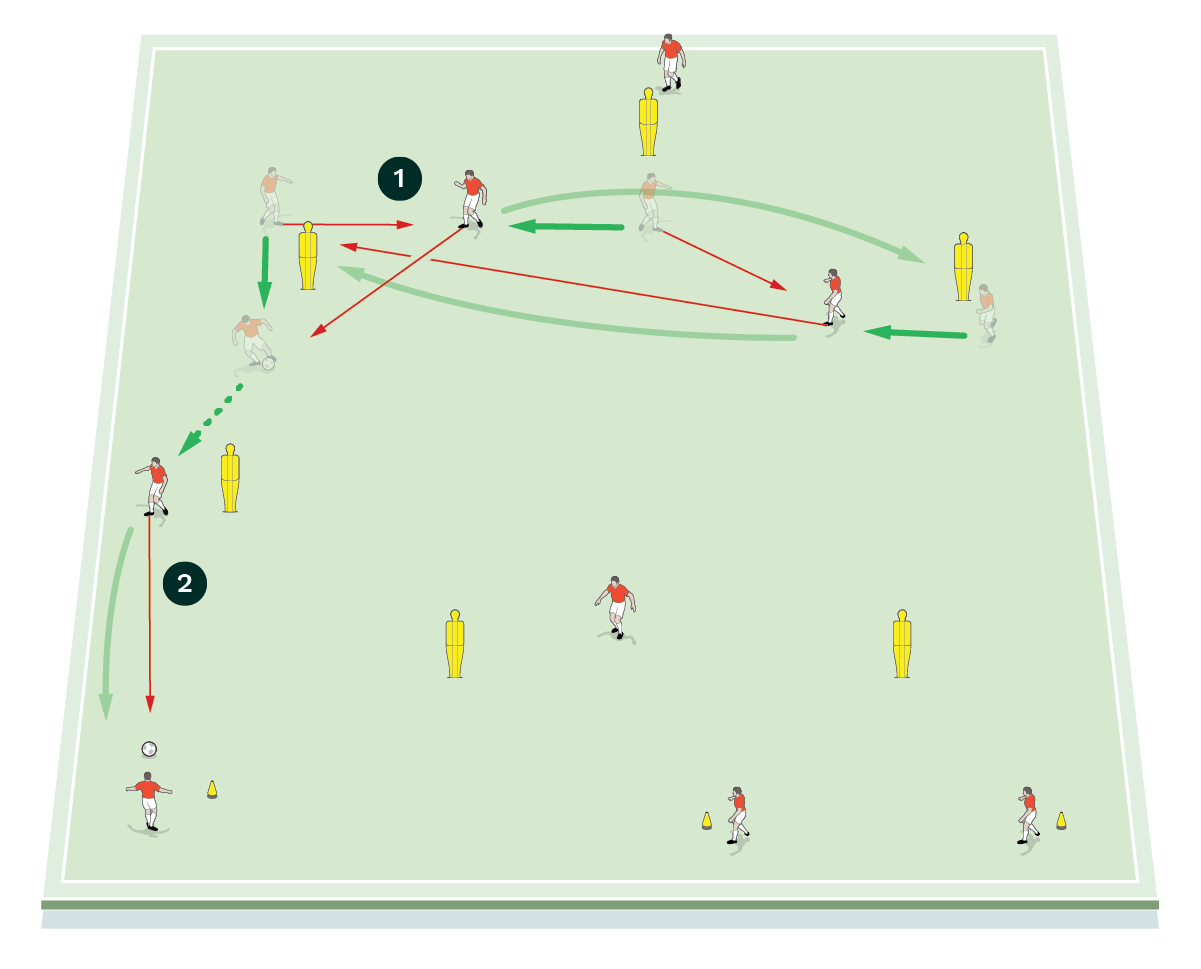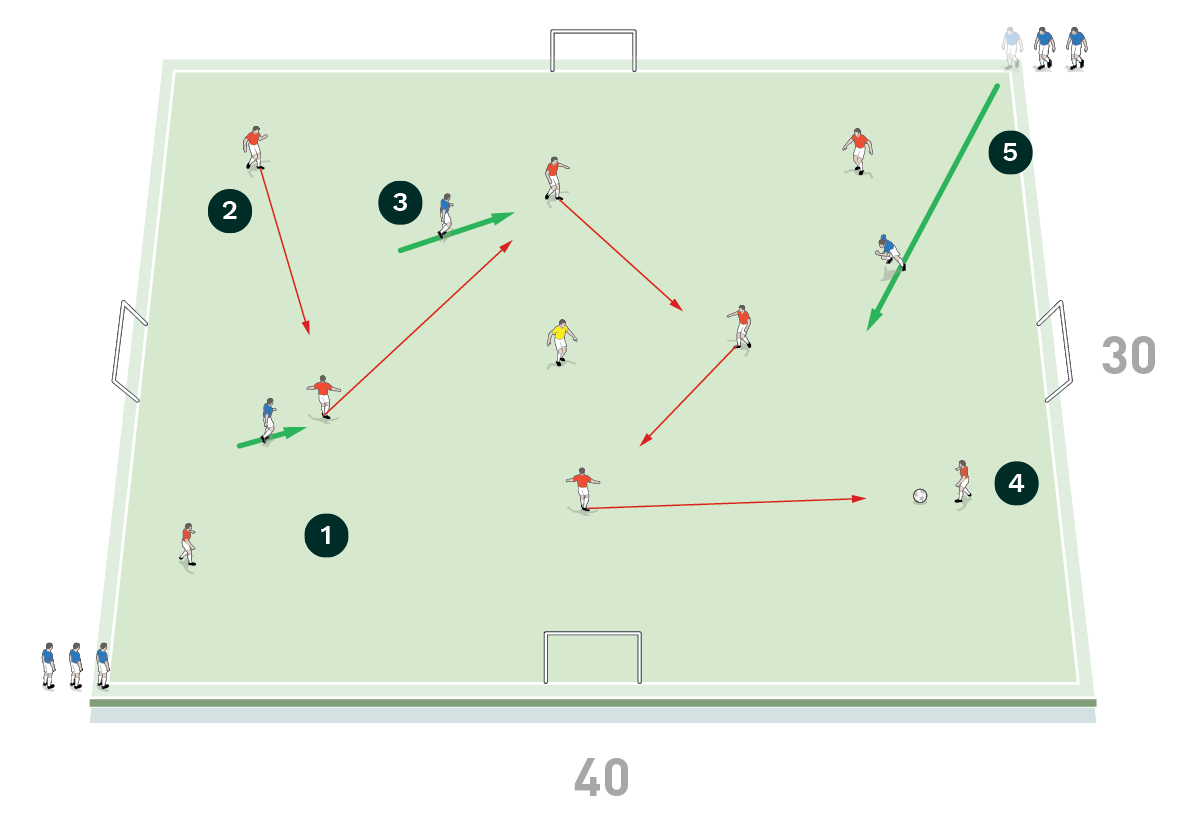This session works on maintaining possession with elements of pressing intensity and transition.

| Area | Up to 30x40-yards |
| Equipment | Balls, bibs, cones, mannequins, 4 mini goals |
| No. of Players | Up to 17 |
| Session Time |
Passing circuit: 10 mins Possession game: 20 mins Small-sided games [not shown]: 30 mins |
This session works on maintaining possession with elements of pressing intensity and transition.
The session begins with a small passing exercise, with two teams setting up with the same patterns, usually patterns we would use tactically for a specific area of the pitch. This practice creates competition, with races to increase tempo, focus and intensity.
The second part of the session is an 8+1 v 2 possession drill with transition into mini goals. The focus is on maintaining ball possession in a small area and, for every five successful passes, the defenders will be able to introduce an additional pressing player which then increases the demands on the possession team.
This is a typical session we would use on a small area high intensity day. There are several variations that we use to both the passing and possession elements that can be changed based on the focus towards the next game.
PASSING CIRCUIT
We set up two 30-yard squares next to each other. Six mannequins and three cones are arranged in each of the squares, as shown. We’re using 16 players, split into two teams of eight, one in each area.
The players run through a passing sequence, set-up at the coach’s choosing dependent upon upcoming opposition challenges. The aim will be that the players are asked to deliver a mixture of short and long, straight and diagonal passing requirements, [1a, 1b].
[1A]

-
Players run through a passing circuit
-
They follow the ball after they have passed it
-
Players receive and execute a mix of short, long, straight and diagonal passes
[1B]

-
To make the exercise as competitive as possible, the two groups can race
-
The aim is to get the ball through the circuit and back to the start point
The mannequins act as visual barriers to avoid. Players rotate roles, following the ball once they have played it.
As a progression and to make the exercise as competitive as possible, the two groups can race each other to get the ball through the circuit and back to the start point.
We run this practice for 10 minutes.
POSSESSION GAME
We set up a playing area of 40x30 yards with a mini goal on each side. We’re using 17 players, split into two teams of eight with one floating player.
The red team start with all eight players on the pitch, alongside the floating player. The blue team has two players on the pitch and six waiting off it, split between opposite corners.
The red team must combine with the floating player to maintain possession. For every five passes the team in possession makes, another defensive player will enter the pitch [2a].
[2a]

-
Players are split into two teams of eight and one floating player
-
The red team starts with all players on the pitch, alongside the floating player
-
The blue team has two players on the pitch and six waiting off it, split between opposite corners
-
The red team and floating players must look to keep possession
-
For every five passes the team makes, a defensive player enters the pitch
If the defending team wins the ball back they have to try and score in one of the four goals for a bonus point, giving the possession team a focus on counter pressing and regaining possession after ball loss. [2b].
[2b]

-
The defending team win the ball back
-
They are now playing with the floating player
-
They must try to score in one of the mini goals to gain a point
If the possession team can counter press and regain the ball they can continue keeping possession [2c].
[2c]

-
Every time the possession team get five passes, another defender enters the pitch
-
If the defending team win the ball, the possession team must counter press to regain
-
Once they’ve regained the ball they can continue keeping possession
Teams switch after eight balls and a total is scored for the possession team. Points are scored for the number of defenders that end up inside the possession square, with bonus points added for defenders if they scored in the mini goals. The pressing team become the possession team and try to beat the score.
The session can be progressed by reducing the pitch area size to demand more from the possession team. Another option is to add in two pressing players every five passes to increase the difficulty in possession.
We run this practice for 20 minutes, in three-minute rounds.
What are the key things to look out for?
In the passing exercise, we’re looking for the timing of the movement, scanning, the speed of the pass and angle of support and the detail of the pass.
In the possession exercise, we’re looking for the team in possession to invite pressure before passing, create angles to receive to play out of pressure, to switch play out of tight areas and for the intensity of the counter press on losing possession.
Out of possession we aim to try not to get split as defenders and to maintain a high intensity of pressure on the ball.
What are the typical mistakes players might make and how can they be avoided?
The timing of the movements in the passing drill can mean players occupy space too early.
In possession, failing to scan to see where new pressure arrives from as it comes from the outside in.
Also, releasing the ball when there is no pressure takes away the time on the ball for the player receiving, shifting the pressure on to that player.
How would you put this into a game situation?
Following this drill, we would progress to small-sided games: 4v4s or 5v5s. We could add conditions to replicate potential game situations, such as positive reactions to possession loss, by offering double points for a goal scored within five seconds of a regain.
We would also encourage the defending team not to get split and make play predictable, which links to the out of possession work in the exercise.

Gary O'Neil
Editor's Picks
Attacking transitions
Deep runs in the final third
Using the goalkeeper in build-up play
Intensive boxes drill with goals
Penetrating the final third
Creating and finishing
My philosophy
Pressing initiation
Compact team movement
Coaches' Testimonials
Coaches' Testimonials
Join the world's leading coaches and managers and discover for yourself one of the best kept secrets in coaching. No other training tool on the planet is written or read by the calibre of names you’ll find in Elite Soccer.
In a recent survey 92% of subscribers said Elite Soccer makes them more confident, 89% said it makes them a more effective coach and 91% said it makes them more inspired.
Get Monthly Inspiration
All the latest techniques and approaches
Since 2010 Elite Soccer has given subscribers exclusive insight into the training ground practices of the world’s best coaches. Published in partnership with the League Managers Association we have unparalleled access to the leading lights in the English leagues, as well as a host of international managers.
Elite Soccer exclusively features sessions written by the coaches themselves. There are no observed sessions and no sessions “in the style of”, just first-hand advice delivered direct to you from the coach.






















